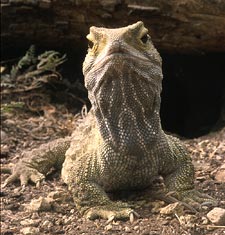Introduction to the Sphenodontidae
Pleurosaurs and the Tuatara
 |
 |
|
|
"Henry", a tuatara at the Southland Museum, New Zealand. At the time this photograph was taken, he was approximately 130 years old. Photos © 2001 Darroch Donald. |
||
Sphenodontids first appear as jaw fossils in the Lower Triassic. However, these fossils do not have enough information to say with certainty that they belong to sphenodontids. Complete skeletons from the Late Triassic of Europe are the oldest undoubted fossils in this group. Fossil sphenodonids were lizard-like in their appearance, which is not surprising since they are closely related. Most were small and terrestrial, though one group (Pleurosaurs) was aquatic.
The Pleurosaurs were long slender reptiles that lived during the Jurassic and Early Cretaceous. Many of the later species had numerous additional vertebrae (backbone elements), with as many as 57 in the trunk alone. In contrast, the legs are greatly reduced, suggesting that they were not very fast or agile on land.
Though only a single species survives today, the Sphenodontidae were rather diverse during the Late Triassic and Jurassic. Additional fossils are known from the Cretaceous, but no Cenozoic fossils have been found. This suggests that the group dwindled in numbers over that time. The modern genus Sphenodon shows little difference in size and structure from known Jurassic fossils — there has been little change in the appearance of sphenodontids over the last 150 million years.